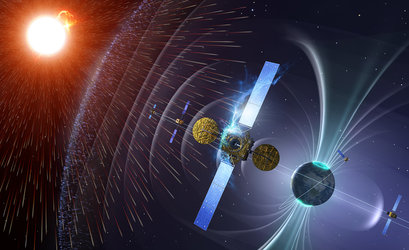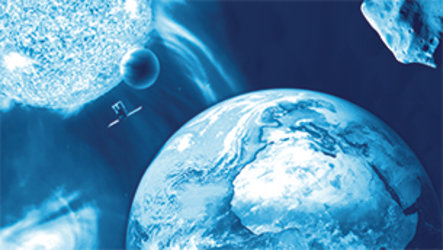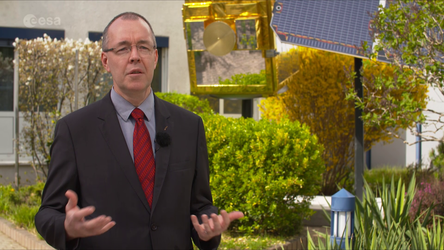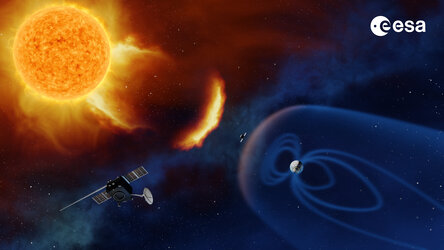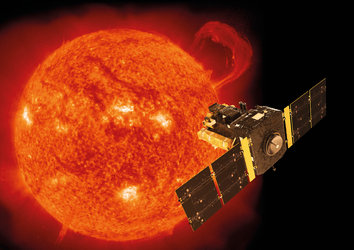ESA expands space weather services
A major expansion in the space weather information and services provided by ESA will help satellites in space and networks like power grids on Earth to cope with solar eruptions.
Scientists, engineers and researchers across Europe are working with ESA to develop a space weather warning system as part of the Agency’s Space Situational Awareness programme.
‘Space weather’ refers to physical conditions at the Sun, in the solar wind and in near-Earth space that can influence the operation of spaceborne and ground systems and affect human health.
The Sun causes ‘storms’ within Earth’s magnetic shield when giant eruptions from its outer atmosphere wash across our planet.
The last period of major storms ended with the Halloween storm of October 2003. A very large solar event in 2012 missed Earth. Smaller eruptions happen regularly and do reach our planet, affecting infrastructure like power grids and networks and interfering with economic activities.
New tools help manage solar effects

In October, ESA’s Space Weather Service Network boosted its portfolio of products – including high-quality data and expert analysis – to more than 100. It released the first versions of 17 new Space Weather Services, each a combination of products, software tools, technical reports and associated expert support, tailored to a given type of affected customer.
“Each of our space weather services is tailored to provide a valuable space weather assessment capability for specific customers,” says ESA’s Juha-Pekka Luntama.
“These span European governments, institutional and commercial users, including satellite designers and operators, those involved in human spaceflight, communication and data network operators and a number of economically important industries, like aviation, oil drilling and navigation.”
Protecting power grids
One of the new services will assist power-grid operators to address a major challenge caused by space weather: magnetically induced currents.
These are caused by rapid variations in Earth’s magnetic field during solar eruptions. In the worst case, they can damage transformers in high-voltage power grids, leading to blackouts.
Realtime predictions of the changes in Earth’s magnetic field will help to reduce the impact of such events.
Coordinating European efforts

In the past 18 months, ESA has coordinated the development of five new Expert Service Centres, each dedicated to bringing together European expertise in a given area of space weather physics, such as space radiation and ionospheric weather, with a focus on service development and provision.
These groups are now providing their data and products to space weather users via a dedicated space weather web portal, with support from ESA’s Space Weather Coordination Centre, hosted at the Space Pole in Brussels.
The Expert Service Centres are teams consisting of a growing network of more than two dozen European and international institutes and research organisations, working with data from a wide range of sources, including satellites such as ESA’s Proba-2, Proba-V and Swarm and the ESA–NASA SOHO solar observatory.
“Expert Service Centres are located across Europe serving as centres of expertise focused on a specific topic within the space weather field. They hold the detailed scientific and technical expertise and assets required for data processing and provision of our services,” says Alexi Glover, ESA’s space weather service development coordinator.
The network also includes a data centre at ESA’s Redu Centre.
A recent analysis of ESA’s Space Situational Awareness programme concluded that space weather hazard-warning and risk-assessment activities would provide a benefit to cost ratio of 6.25 over 16 years.
The benefits from industrial investments, technology development and avoided effects on civil infrastructure and society were estimated at €2635 million.
These and other developments related to space weather activities will be highlighted at the European Space Weather Week, 14–18 November, in Oostende, Belgium.
The annual event is Europe’s top forum for space weather scientists and experts and is coordinated by the Belgian Solar–Terrestrial Centre of Excellence, ESA and the Space Weather Working Team.















 Germany
Germany
 Austria
Austria
 Belgium
Belgium
 Denmark
Denmark
 Spain
Spain
 Estonia
Estonia
 Finland
Finland
 France
France
 Greece
Greece
 Hungary
Hungary
 Ireland
Ireland
 Italy
Italy
 Luxembourg
Luxembourg
 Norway
Norway
 The Netherlands
The Netherlands
 Poland
Poland
 Portugal
Portugal
 Czechia
Czechia
 Romania
Romania
 United Kingdom
United Kingdom
 Slovenia
Slovenia
 Sweden
Sweden
 Switzerland
Switzerland


























